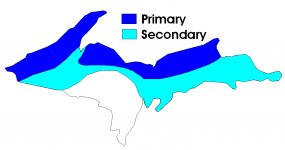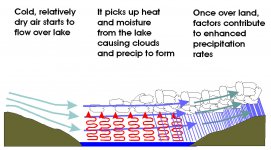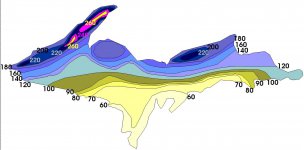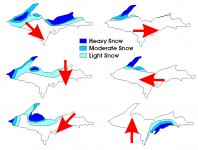To answer your question on what is needed to get the LES (Lake Effect Snow) machine going:
First, you need the temperature difference between the lake and the air at 850 mb (delta T) to be 13 degrees C. To convert this to more common parameters, a difference in temperature of about 28-30 degrees F. between the lake water and the air at about 2-3000 feet needs to be present. Currently the lake is at about 2-4 deg. C (36-40 deg F.) and will stay there for most of the rest of the season.
Next you need the proper wind direction to move the clouds and snow over the location of interest. A west, northwest wind is best for the Keweenaw, as it gives the longest fetch of water for the air to travel over. Although, we can get LES with any wind direction but south. The very tip of the Keweenaw can even get it with a south wind.
Once you have these two factors going, some other factors which help to produce the heavier snows are:
The higher the Delta T, the heavier the snow.
The more unstable the atmosphere the higher the clouds will form, the higher the clouds, the heavier the snow. What I mean by an unstable atmosphere is that the air is cooling with height faster than what would normally occur in nature. If you lift a parcel of air, it will be allowed to expand with the lower pressures around it. This expansion of the air will cause it to cool. This rate of cooling is called the "standard lapse rate". As long as the lapse rate occurring with the current atmospheric conditions is larger (cooling faster) than the standard lapse rate, the parcel will continue to rise. An inversion is when the air temperature rises with height. Low level inversions are quite common with arctic air outbreaks, as the cold air is usually fairly shallow, 2-5000 ft. An inversion at about 1000-1500 feet or less will kill lake effect snow, no matter how cold it is at the surface to 2000 feet.
Another feature is how much moisture is in the air upstream of the lake. The drier the air, the less moisture it has to start out with and thus the less moisture it will be able to return as snow.
The last two are derived around the wind. The stronger the wind, the less time the air has to be over the lake and less time it has to pick up warmth and moisture. Also, winds blowing out of the same direction through the different levels of the atmosphere is called uni-directional winds. Uni-directional winds also allow the clouds to form to higher levels, producing heavier snow.
So the dream scenario for lake effect snow for the Keweenaw is to have large lake/850 delta T's, on the order of 20 degrees C or more. Winds out of the west, northwest. An unstable atmosphere, with inversion highs of 7000 feet or more. Realtively moist air upwind of the lake. Uni-directional winds blowing at about 10-15 MPH or less. This would produce snows on the order of 1-3"/hr.
Tonight ( Wednesday, January 19th) we have 2 of the parameters met. Lake/850 delts [sic: "delta"] T's are at about 10-20 degrees C and will go to about 24 by tomorrow AM (24 is quite respectable), and the winds are not blowing too hard. Other than that, there is an inversion at about 1500 ft, the winds are not uni-directional and the air upwind is dry. That is why things are not cranking right now and snowfall rates are at about 1"/3-4 hours. It looks like the winds will become more uni-directional tonight, but be mainly out of the north. By later tomorrow (Thursday), the direction could become more out of the NW. A pocket of upper air energy is also indicated to slip across the region by later tomorrow or early Friday. This will help to raise the inversion hight [sic] from about 1500 ft to the 3-4000 ft level. Thus, it looks like the heaviest snow in the Keweenaw with this event might actually play out for later tomorrow into early Friday, with rates of .5-1"/hr possible. That is if what the computer models are now indicating. Well see if it comes true. Lake effect can be a real fickle thing!

 ), but here are two of John's previous dissertations on LES.
), but here are two of John's previous dissertations on LES.



